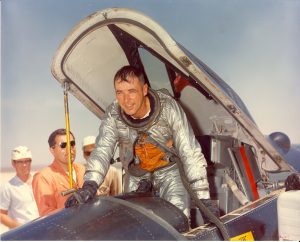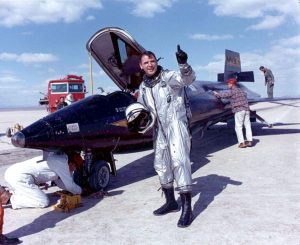7 March 1961 – “Launched over Silver Lake, a dry lake bed near the California/Nevada border, at 10:28:33.0 a.m., Pacific Standard Time, test pilot Major Robert M. White, U.S. Air Force, flew the number two North American Aviation X-15 hypersonic research rocketplane, 56-6671, to Mach 4.43 (2,905 miles per hour/4,675 kilometers per hour) and 77,450 feet (23,607 meters), becoming the first pilot to exceed Mach 4.

This was the first flight for the number two X-15 with the Reaction Motors XLR99-RM-1 engine, which was rated at 57,000 pounds of thrust (253.55 kilonewtons).
The flight plan called for a burn time of 116 seconds, an altitude of 84,000 feet (25,603 meters), and a predicted maximum speed of Mach 4.00. The actual duration of the engine burn was 127.0 seconds. Peak altitude was lower than planned, at 77,450 feet (23,607 meters). The longer burn and lower altitude translated into the higher speed.
The total duration of the flight, from the airdrop from the Boeing NB-52B Stratofortress carrier, 52-008, to touchdown at Edwards Air Force Base, was 8 minutes, 34.1 seconds.“(1)
During World War II, White served with the 355th Fighter Group in the European Theater of Operations. He flew P-51 Mustangs from July 1944 until February 1945, when he was shot down over Germany on his 52nd combat mission. He was captured and remained a prisoner of war until his release in April 1945.
He then returned to the United States, left active duty in December 1945, and became a member of the Air Force Reserve at Mitchel Air Force Base, New York, while studying Electrical Engineering at New York University. He earned his Bachelor of Science degree from there in 1951, and a Master of Business Administration degree from the George Washington University in 1966.
White was recalled to active duty in May 1951 for the Korean War, where he served as a pilot and engineering officer with the 514th Troop Carrier Wing at Mitchel Air Force Base. In February 1952, he was assigned as a fighter pilot and flight commander with the 40th Fighter-Interceptor Squadron, based at Johnson Air Base, Japan. In August 1953, he returned from overseas to serve as a systems engineer at Rome Air Development Center, Griffiss Air Force Base, New York.
White attended the United States Air Force’s Experimental Flight Test Pilot School at Edwards Air Force Base, California, and became a test pilot, flying advanced models such as the F-86 Sabre, F-89 Scorpion, the new F-102 Delta Dagger, the F-104 Starfighter, and the F-105 Thunderchief.
In October 1963, he returned to Germany, where he served as operations officer for the 22d Tactical Fighter Squadron, 36th Tactical Fighter Wing, flying F-105 Thunderchiefs at Bitburg Air Base, and from July 1964 to August 1965 as commander of the wing’s 53d Tactical Fighter Squadron. He returned to the United States in August 1965 to attend the Industrial College of the Armed Forces, Washington, DC and graduated a year later. During the same period, he attended George Washington University, receiving his Master of Business Administration degree in 1966. Lieutenant Colonel White then was transferred to Air Force Systems Command at Wright-Patterson Air Force Base, Ohio, as chief of the Tactical Systems Office, F-111 Systems Program Office, where he served from September 1966 to May 1967.
In May 1967, during the Vietnam War, Colonel White was assigned as Deputy Commander for Operations of the 355th Tactical Fighter Wing, an F-105 unit based at Takhli Royal Thai Air Force Base, Thailand. He flew 70 combat missions over North Vietnam, including leading an attack against the Paul Doumer Bridge in Hanoi on August 11, 1967, for which he was awarded the Air Force Cross. He was transferred in October to the Seventh Air Force Headquarters at Tan Son Nhut Air Base, South Vietnam, serving as chief of the Attack Division in the Directorate of Combat Operations.
White returned to the United States and Wright-Patterson Air Force Base in June 1968, where he served as director of the F-15 Eagle Systems Program, responsible for managing development and production planning, in the Aeronautical Systems Division, Air Force Systems Command.” (2)
Source: (1) ThisDayinAviation by Bryan R. Swopes, c.2017; (2) Wikipedia
